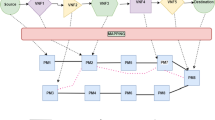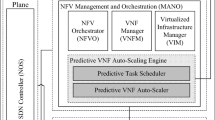Abstract
Network Function Virtualization (NFV) has been identified to revamp the provisioning of next-generation network services. This new paradigm allows cloud and network/service providers to compose their network services, also known as service function chains (SFCs), in an agile way since the software of the network function is decoupled from the legacy hardware. To reap the benefits of this new technology, there is a need for novel mechanisms that help cloud and network/service providers deploy the increasingly complex virtual network services seamlessly, efficiently, and in a time-efficient way. Existing state-of-the-art techniques often rely on the Integer Linear Programming framework, heuristics/metaheuristics, and greedy methods to deploy the services function chains. However, these techniques although reasonable and acceptable, still suffer from several key limitations: convergence time and scalability. To this end, we propose RAFALE, a suite of solution techniques, to tame this complexity by leveraging the concept of similarity from machine learning and skip-gram modeling framework. To the best of our knowledge, we are the first to tackle these key limitations and propose a suite of solutions to them. RAFALE, a novel approach proposed to find the similarity between the new incoming virtual network service request and all the already-deployed services to learn from the previous experience of deploying techniques and use the same or close similar provisioning techniques. RAFALE is the first and the only method that develops the idea of detecting the similarity between virtual network services. Experimental results show that RAFALE reduces greatly the convergence time needed for provisioning virtual network services and can scale to 100 virtual network functions per virtual network service compared to the state-of-the-art. The Experimental results prove that RAFALE accomplished the NFV promises; decreasing the time and complexity of managing and deploying the virtual services, and providing a solution that is agile, faster, and scalable to deploy the new service requests by skipping one or more service provisioning steps (i.e., detecting and resolving the conflicts among policies, placement, and chaining) while satisfying the validated NFV policies.










Similar content being viewed by others
References
Yi B et al (2018) A comprehensive survey of network function virtualization. Comput Netw 133:212–262
Ghaznavi M et al (2017) Distributed service function chaining. IEEE J Sel Areas Commun 35(11):2479–2489
Mostafavi S, Hakami V, Sanaei M (2021) Quality of service provisioning in network function virtualization: a survey. Computing 103(5):917–991
Bany Taha M et al (2020) TD-PSO: task distribution approach based on particle swarm optimization for vehicular ad hoc network. Trans Emer Telecommun Technol 33:e3860
Maaroufi S, Pierre S (2021) BCOOL: a novel blockchain congestion control architecture using dynamic service function chaining and machine learning for next generation vehicular networks. IEEE Access 9:53096–53122
Augustine WA (2021) Applying machine learning on linux interprocess communication graphs for intrusion detection. State University of New York, Albany
Rotsos C et al (2017) Network service orchestration standardization: A technology survey. Comput Stand Inter 54:203–215
Kuncan M, Ömer Ç (2019) Akıllı Ev Teknolojisi için Kablosuz Akıllı Kit. Avrupa Bilim ve Teknoloji Dergisi 17:271–282
Çubukçu A. et al. (2015) Development of a voice-controlled home automation using Zigbee module. In: 2015 23nd Signal Processing and Communications Applications Conference (SIU). 2015. IEEE.
Houidi O, (2020) Algorithms for virtual network functions chaining. 2020, Institut polytechnique de Paris.
Laaziz L et al (2019) FASTSCALE: A fast and scalable evolutionary algorithm for the joint placement and chaining of virtualized services. J Netw Comput Appl 148:102429
Ayoubi S, Chowdhury SR, and Boutaba R. (2018) Breaking service function chains with Khaleesi. In: 2018 IFIP Networking Conference (IFIP Networking) and Workshops. 2018. IEEE
Alleg A, et al. (2017) Delay-aware VNF placement and chaining based on a flexible resource allocation approach. in 2017 13th International Conference On Network And Service Management (CNSM). 2017. IEEE.
Pham C et al (2017) Traffic-aware and energy-efficient vNF placement for service chaining: joint sampling and matching approach. IEEE Trans Serv Comput 13(1):172–185
Khebbache S, Hadji M, Zeghlache D (2017) Virtualized network functions chaining and routing algorithms. Comput Netw 114:95–110
Cziva R, Anagnostopoulos C, Pezaros DP (2018) Dynamic, latency-optimal vNF placement at the network edge. In: IEEE infocom 2018-ieee conference on computer communications. IEEE, pp 693–701
Luizelli MC et al (2017) A fix-and-optimize approach for efficient and large scale virtual network function placement and chaining. Comput Commun 102:67–77
Li D, Hong P, Xue K (2018) Virtual network function placement considering resource optimization and SFC requests in cloud datacenter. IEEE Trans Parallel Distrib Syst 29(7):1664–1677
Bari MF et al. (2015) On orchestrating virtual network functions. In: 2015 11th International Conference on Network and Service Management (CNSM). 2015. IEEE
Anwer B, et al. (2015) Programming slick network functions. In: Proceedings of the 1st Acm Sigcomm Symposium on Software Defined Networking Research
Gonzalez AJ et al (2018) Dependability of the NFV orchestrator: State of the art and research challenges. IEEE Commun Surv Tutorials 20(4):3307–3329
Mikolov T et al (2013) Distributed representations of words and phrases and their compositionality. Adv Neural Inform Proc Syst 26:1
Narayanan A, et al (2017) graph2vec: Learning distributed representations of graphs. arXiv preprint arXiv:1707.05005
Le Q, T (2014) Mikolov. Distributed representations of sentences and documents. In: International Conference on Machine Learning. 2014. PMLR.
Jiang C, Coenen F, Zito M (2013) A survey of frequent subgraph mining algorithms. The Knowledge Engineering Review 28(1):75–105
Yan X, Han J (2002) gspan: Graph-based substructure pattern mining. In: 2002 IEEE International Conference on Data Mining, Proceedings. IEEE
Bouten N et al (2017) Semantically enhanced mapping algorithm for affinity-constrained service function chain requests. IEEE Trans Netw Serv Manage 14(2):317–331
Bonfim M, Freitas F, Fernandes S (2019) A semantic-based policy analysis solution for the deployment of nfv services. IEEE Trans Netw Serv Manage 16(3):1005–1018
Sundararajan PK, et al. (2015) A constrained genetic algorithm for rebalancing of services in cloud data centers. In: 2015 IEEE 8th International Conference on Cloud Computing. IEEE
Pachorkar N, Ingle R (2013) Multi-dimensional affinity aware VM placement algorithm in cloud computing. Int J Adv Comput Res 3(4):121
Lorenz C et al (2017) An SDN/NFV-enabled enterprise network architecture offering fine-grained security policy enforcement. IEEE Commun Mag 55(3):217–223
Taha M et al (2020) Adaptive ciphertext policy attribute based encryption scheme for internet of things devices using decision tree. Rev d’Intelligence Artif 34(3):233–241
Konstanteli K et al (2014) Elastic admission control for federated cloud services. IEEE Trans Cloud Comput 2(3):348–361
Macías M, Guitart J (2014) SLA negotiation and enforcement policies for revenue maximization and client classification in cloud providers. Futur Gener Comput Syst 41:19–31
ETSI, Network functions virtualisation (nfv); management and orchestration;report on policy management in mano
Zou D et al (2018) Solving anomalies in NFV-SDN based service function chaining composition for IoT network. IEEE Access 6:62286–62295
Basile C et al (2016) Inter-function anomaly analysis for correct SDN/NFV deployment. Int J Netw Manag 26(1):25–43
Bringhenti D et al (2020) Improving the formal verification of reachability policies in virtualized networks. IEEE Trans Netw Serv Manage 18(1):713–728
Fang Y, Cai Z (2020) Reinforcement learning based heterogeneous resource provisioning for cloud web applications. In: 2020 IEEE 22nd International Conference on High Performance Computing and Communications; IEEE 18th International Conference on Smart City; IEEE 6th International Conference on Data Science and Systems (HPCC/SmartCity/DSS). IEEE
Wang L et al (2016) Joint optimization of service function chaining and resource allocation in network function virtualization. IEEE Access 4:8084–8094
Ye Z et al (2016) Joint topology design and mapping of service function chains for efficient, scalable, and reliable network functions virtualization. IEEE Network 30(3):81–87
Hawilo H, Jammal M, Shami A (2019) Network function virtualization-aware orchestrator for service function chaining placement in the cloud. IEEE J Sel Areas Commun 37(3):643–655
Zhou R (2018) An online placement scheme for VNF chains in geo-distributed clouds. In: 2018 IEEE/ACM 26th International Symposium on Quality of Service (IWQoS). IEEE.
Dieye M et al (2018) CPVNF: Cost-efficient proactive VNF placement and chaining for value-added services in content delivery networks. IEEE Trans Netw Serv Manage 15(2):774–786
Miotto G et al (2019) Adaptive placement & chaining of virtual network functions with NFV-PEAR. J Int Serv Appl 10(1):1–19
Alameddine HA, Sebbah S, Assi C (2017) On the interplay between network function mapping and scheduling in VNF-based networks: A column generation approach. IEEE Trans Netw Serv Manage 14(4):860–874
Moualla G, Turletti T, Saucez D (2019) Online robust placement of service chains for large data center topologies. IEEE Access 7:60150–60162
Khebbache S, Hadji M, Zeghlache D (2017) Scalable and cost-efficient algorithms for VNF chaining and placement problem. In: 2017 20th Conference on Innovations in Clouds, Internet and Networks (ICIN). IEEE
Tajiki MM et al (2018) Joint energy efficient and QoS-aware path allocation and VNF placement for service function chaining. IEEE Trans Netw Serv Manage 16(1):374–388
Jang I et al (2017) Joint optimization of service function placement and flow distribution for service function chaining. IEEE J Sel Areas Commun 35(11):2532–2541
Guthrie D, et al. A closer look at skip-gram modelling. In: LREC. 2006. Citeseer
Zobaed S et al. (2018) Nocs2: Topic-based clustering of big data text corpus in the cloud. In: 2018 21st International Conference of Computer and Information Technology (ICCIT). IEEE
Zhang Y et al. (2018) A light-weight and quality-aware online adaptive sampling approach for streaming social sensing in cloud computing. In: 2018 IEEE 24th International Conference on Parallel and Distributed Systems (ICPADS). IEEE
de Oliveira NR et al (2021) Identifying fake news on social networks based on natural language processing: trends and challenges. Information 12(1):38
Zhao F et al (2015) A skip-gram-based framework to extract knowledge from chinese reviews in cloud environment. Mobile Netw Appl 20(3):363–369
Pérez-Romero J et al. (2018) Monitoring and analytics for the optimisation of cloud enabled small cells. In: 2018 IEEE 23rd International Workshop on Computer Aided Modeling and Design of Communication Links and Networks (CAMAD). IEEE
Wang H (2017) A mobile world made of functions. APSIPA Trans Signal Inform Proc. https://doi.org/10.1017/ATSIP.2017.2
Zhao R, Iwaihara M (2017) Lightweight efficient multi-keyword ranked search over encrypted cloud data using dual word embeddings. arXiv preprint arXiv:1708.09719
Lahlou L, et al. (2021) RAFALE: smaRt and scalable orchestrAtion system For virtuAL network sErvices. in 2021 IEEE 22nd International Conference on High Performance Switching and Routing (HPSR). IEEE
Soualah O et al (2019) Online and batch algorithms for VNFs placement and chaining. Comput Netw 158:98–113
Acknowledgements
This work has been supported by Ericsson Canada and the Natural Sciences and Engineering Research Council of Canada (NSERC).
Author information
Authors and Affiliations
Corresponding author
Additional information
Publisher's Note
Springer Nature remains neutral with regard to jurisdictional claims in published maps and institutional affiliations.
Rights and permissions
About this article
Cite this article
Suwi, H., Lahlou, L., Kara, N. et al. RAFALE: Rethinking the provisioning of virtuAl network services using a Fast and scAlable machine LEarning approach. J Supercomput 78, 15786–15819 (2022). https://doi.org/10.1007/s11227-022-04492-6
Accepted:
Published:
Issue Date:
DOI: https://doi.org/10.1007/s11227-022-04492-6




